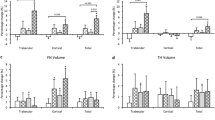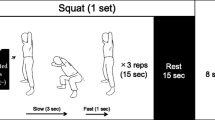Abstract
It is an important aim in the prevention of osteoporosis to stop or decelerate bone loss during the early postmenopausal years. Here we report on results of the 3-year EFOPS exercise trial in osteopenic women. The exercise strategy emphasized low-volume high-resistance strength training and high-impact aerobics. Forty-eight fully compliant women (55.1±3.3 years) with no medication or illness affecting bone metabolism participated in the exercise group (EG); 30 women (55.5±3.0 years) served as non-training controls (CG). At baseline there were no significant between-group differences with respect to physical fitness, bone mineral density, pain and nutritional status. The training consisted of two group training and two home training sessions per week. The study participants of both groups were individually supplemented with calcium and vitamin D (cholecalciferol). Bone mineral density (BMD) was measured by DXA at the lumbar spine, proximal femur and distal forearm and by QCT at the lumbar spine. Speed of sound and broadband ultrasound attenuation were determined at the calcaneus by quantitative ultrasound (QUS). Pain frequency and intensity at different skeletal sites were assessed via questionnaire. After 38 months, the following within-group changes were measured: DXA lumbar spine, EG: 0.8% n.s.; CG: −3.3% P <0.001; QCT trabecular ROI, EG: 1.1% n.s; CG: −7.7% P <0.001; QCT cortical ROI, EG: 5.3% P <0.001; CG: −2.6% P <0.001; DXA total hip: EG: −0.2% n.s; CG −1.9%, P <0.001; DXA distal forearm, EG: −2.8% P <0.001; CG: −3.8% P <0.001; BUA, EG: −0.3% n.s; CG −5.4% P <0.001; SOS, EG: 0.3% n.s; CG −1.0% P <0.001. At year 3 between-group differences relative to the exercise group were: DXA lumbar spine: 4.1% P <0.001; QCT trabecular ROI: 8.8% P <0.001; QCT cortical ROI: 7.9% P <0.001; DXA total hip: 2.1%, P <0.001; DXA distal forearm: 1.0% n.s.; BUA: 5.8% P <0.05; SOS: 1.3% P <0.001. Pain frequency and intensity in the spine significantly decreased in the exercise group and increased in the control group, while no between-group differences were detected in the main joints. In summary, over a period of 3 years our low-volume/high-intensity exercise program was successful to maintain bone mineral density at the spine, hip and calcaneus, but not at the forearm.





Similar content being viewed by others
References
Okano H, Mizunuma H, Soda M, Kagami I, Miyamoto S, Ohsawa M, Ibuki Y, Shiraki M, Suzuki T, Shibata H (1998) The long-term effect of menopause on postmenopausal bone loss in Japanese women: results from a prospective study. J Bone Miner Res 13:303–309
Shipman AJ, Guy GW, Smith I, Ostlere S, Greer W, Smith R (1999) Vertebral bone mineral density, content and area in 8,789 normal women aged 33–73 years who have never had hormone replacement therapy. Osteoporos Int 9:420–426
Cauley JA, Robbins J, Chen Z, Cummings SR, Jackson RD, LaCroix AZ, LeBoff M, Lewis CE, McGowan J, Pettinger M, Stefanick ML, Wactawski-Wende J, Watts NB (2003) Effects of estrogen plus progestin on risk of fracture and bone mineral density: the Women’s Health Initiative randomized trial. JAMA 290:1729–1738
Burghardt M (1999) Exercise at menopause: a critical difference. Medscape Womens Health 4:1
Kelley GA, Kelley KS, Tran ZV (2000) Exercise and bone mineral density in men: a meta-analysis. J Appl Physiol 88:1730–1736
Vuori IM (2001) Dose-response of physical activity and low back pain, osteoarthritis, and osteoporosis. Med Sci Sports Exerc 33:S551–S586
Wolff I, van Croonenborg JJ, Kemper HC, Kostense PJ, Twisk JW (1999) The effect of exercise training programs on bone mass: a meta-analysis of published controlled trials in pre- and postmenopausal women. Osteoporos Int 9:1–12
Kemmler W, Engelke K (2004) A critical review of exercise training effects on bone mineral density (BMD) in early postmenopausal women. Int Sportmed J 5:67–77
Kemmler W, Engelke K., Lauber D, Weineck J, Hensen J, Kalender WA (2003) The Erlangen Fitness Osteoporosis Prevention Study (EFOPS)—a controlled exercise trial in early postmenopausal women with low bone density: first year results. Arch Phys Med Rehabil 84:673–683
Kemmler W, Engelke K, Lauber D, Weineck J, Hensen J, Kalender WA (2004) Impact of intense exercise on physical fitness, quality of life, and bone mineral density in early postmenopausal women. Year 2 results of the Erlangen Fitness Osteoporosis Prevention Study (EFOPS). Arch Int Med 164:1084–1091
Kalender WA, Klotz E, Süss C (1987) Vertebral bone mineral analysis: an integrated approach with CT. Radiology 164:419–423
Investigators (1997) Measuring quality of life in women with osteoporosis. The Osteoporosis Quality of Life Study Group. Osteoporos Int 7:478–487
Kemmler W, Riedel H (1998) Körperliche Belastung und Osteoporose—Einfluß einer 10 monatigen Interventionsmaßnahme auf ossäre und extraossäre Risikofaktoren einer Osteoporose. Dtsch Z Sportmed 49:270–277
Turner CH (1991) Homeostatic control of bone structure: an application of feedback theory. Bone 12:203–217
Frost HM (1992) The role of changes in mechanical usage set points in the pathogenesis of osteoporosis. J Bone Miner Res 7:253–261
Grove KA, Londeree BR (1992) Bone density in postmenopausal women: high impact vs low impact exercise. Med Sci Sports Exerc 24:1190–1194
Martin D, Notelovitz M (1993) Effects of aerobic training on bone mineral density of postmenopausal women. J Bone Miner Res 8:931–936
Sugiyama T, Yamaguchi A, Kawai S (2002) Effects of skeletal loading on bone mass and compensation mechanism in bone: a new insight into the “mechanostat” theory. J Bone Miner Metab 20:196–200
Bemben DA, Fetters NL, Bemben MG, Nabavi N, Koh ET (2000) Musculoskeletal responses to high- and low-intensity resistance training in early postmenopausal women. Med Sci Sports Exerc 32:1949–1957
Heikkinen J, Kyllönen E, Kurttila-Matero E, Wilén-Rosenqvist G, Lankinen KS, Rita H, Väänänen HK (1997) HRT and exercise: effects on bone density, muscle strength and lipid metabolism. A placebo controlled 2-year prospective trial on two estrogen-progestin regimens in healthy postmenopausal women. Maturitas 26:139–149
Pruitt LA, Jackson RD, Bartels RL, Lehnhard HJ (1992) Weight-training effects on bone mineral density in early postmenopausal women. J Bone Miner Res 7:179–185
Cheng S, Sipila S, Taaffe DR, Puolakka J, Suominen H (2002) Change in bone mass distribution induced by hormone replacement therapy and high-impact physical exercise in post-menopausal women. Bone 31:126–135
Kemmler W (1999) Einfluß unterschiedlicher Lebensabschnitte auf die belastungsabhängige Reaktion ossärer Risikofaktoren einer Osteoporose. Dtsch Z Sportmed 50:114–119
Kelley GA (1998) Exercise and regional bone mineral density in postmenopausal women: a meta-analytic review of randomized trials. Am J Phys Med Rehabil 77:76–87
Wallace BA, Cumming RG (2000) Systematic review of randomized trials of the effect of exercise on bone mass in pre- and postmenopausal women. Calcif Tissue Int 67:10–18
Bailey DA, McCulloch RG (1990) Bone tissue and physical activity. Can J Sport Sci 15:229–239
Birkhäuser M (1991) Postmenopausale Osteoporose: Pathophysiologie und Prophylaxe. Schweizerische Rundschau Medizin (Praxis) 80:418–422
Ettinger B (1988) Prevention of osteoporosis: treatment of estradiol deficiency. Obstet Gynecol 72:1–6
Prevrhal S, Engelke K, Kalender WA (1999) Accuracy limits for the determination of cortical width and density: the influence of object size and CT imaging parameters. Phys Med Bio 44:751–764
Jones PRM, Hardmann AE, Hudson A, Norgan NG (1991) Influence of brisk walking on the ultrasonic attenuation of the calcaneus in previously sedentary women aged 30–61 years. Calcif Tissue Int 49:112–115
Chan K, Qin L, Lau M, Woo J, Au S, Choy W, Lee K, Lee S (2004) A randomized, prospective study of the effects of Tai Chi Chun exercise on bone mineral density in postmenopausal women. Arch Phys Med Rehabil 85:717–722
Kerr D, Morton A, Dick I, Prince R (1996) Exercise effects on bone mass in postmenopausal women are site-specific and load-dependent. J Bone Miner Res 11:218–225
McMurdo ME, Mole PA, Paterson CR (1997) Controlled trial of weight bearing exercise in older women in relation to bone density and falls. BMJ 314:569
Preisinger E, Alacamlioglu Y, Pils K, Saradeth T, Schneider B (1995) Therapeutic exercise in the prevention of bone loss. Am J Phys Med Rehabil 74:120–123
Preisinger E, Alacamlioglu Y, Pils K, Bosina E, Metka M, Schneider B, Ernst E (1996) Exercise therapy for osteoporosis: results of a randomised controlled trial. Br J Sports Med 30:209–212.
Qin L, Au S, Choy W, Leung P, Neff M, Lee K, Lau M, Woo J, Chan K (2002) Regular Tai Chi Chuan exercise may retard bone loss in postmenopausal women: a case-control study. Arch Phys Med Rehabil 83:1355–1359
Simkin A, Ayalon J, Leichter I (1987) Increased trabecular bone density due to bone-loading exercises in postmenopausal osteoporotic women. Calcif Tissue Int 40:59–63
Adami S, Gatti D, Braga V, Bianchini D, Rossini M (1999) Site-specific effects of strength training on bone structure and geometry of ultradistal radius in postmenopausal women. J Bone Miner Res 14:120–124
Burr DB, Milgrom C, Fyhrie D, Forwood M, Nyska M, Finestone A, Hoshaw S, Saiag E, Simkin A (1996) In vivo measurement of human tibial strains during vigorous activity. Bone 18:405–410
Milgrom C, Miligram M, Simkin A, Burr D, Ekenman I, Finestone A (2001) A home exercise program for tibial bone strengthening based on in vivo strain measurements. Am J Phys Med Rehabil 80:433–438
Cullen DM, Smith RT, Akhter MP (2001) Bone-loading response varies with strain magnitude and cycle number. J Appl Physiol 91:1971–1976
Turner CH, Forwood MR, Otter MW (1994) Mechanotransduction in bone: do bone cells act as sensors of fluid flow? Faseb J 8:875–878
Rubin CT, Lanyon LE (1984) Regulation of bone formation by applied dynamic loads. J Bone Joint Surg Am 66:397–402
Robling AG, Burr DB, Turner CH (2001) Recovery periods restore mechanosensitivity to dynamically loaded bone. J Exp Biol 204:3389–3399
Srinivasan S, Gross TS (2000) Intermittend rest enhances osteoblastic activation induced by mechanical loading. Trans Orthop Res Soc 25:628
Umemura Y, Sogo N, Honda A (2002) Effects of intervals between jumps or bouts on osteogenic response to loading. J Appl Physiol 93:1345–1348
Turner CH, Robling AG (2004) Exercise as an anabolic stimulus for bone. Curr Pharm Des 10:2629–2641
Kraemer WJ (1992) Endocrine responses and adaptions to strength training. In: Komi V (ed) Strength and power in sport. Blackwell, Oxford, pp 291–304
Kemmler W, Wildt L, Engelke K, Pintag P, Pavel M, Bracher B, Weineck J, Kalender W (2003) Acute hormonal responses of a high impact physical exercise session in early postmenopausal women. Eur J Appl Physiol 90:199–209
Turner CH (1998) Exercise as a therapy for osteoporosis: the drunk and the street lamp, revisited. Bone 23:83–85
Kemmler W, Lauber D, von Stengel S, Weineck J, Kalender WA, Engelke K (2005) Exercise effects on risk factors in early postmenopausal women: 3y EFOPS results. Med Sci Sports Exerc 37:194–203
Acknowledgements
We gratefully acknowledge the support of Sanofi-Synthelabo GmbH (Henning, Berlin, Germany) who supplied calcium and vitamin D for all study participants. We also acknowledge the supply of the Therabands by Thera-Band GmbH (Hadamar, Germany) and support by the Universitäts-Bund Erlangen.
Author information
Authors and Affiliations
Corresponding author
Rights and permissions
About this article
Cite this article
Engelke, K., Kemmler, W., Lauber, D. et al. Exercise maintains bone density at spine and hip EFOPS: a 3-year longitudinal study in early postmenopausal women. Osteoporos Int 17, 133–142 (2006). https://doi.org/10.1007/s00198-005-1938-9
Received:
Accepted:
Published:
Issue Date:
DOI: https://doi.org/10.1007/s00198-005-1938-9




